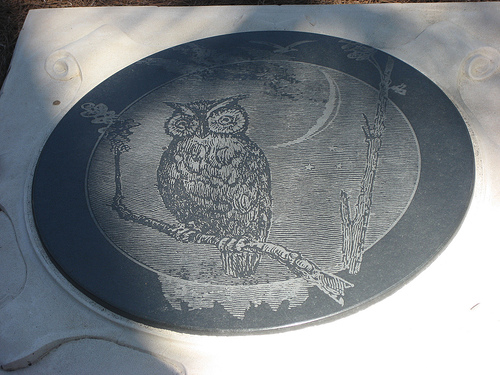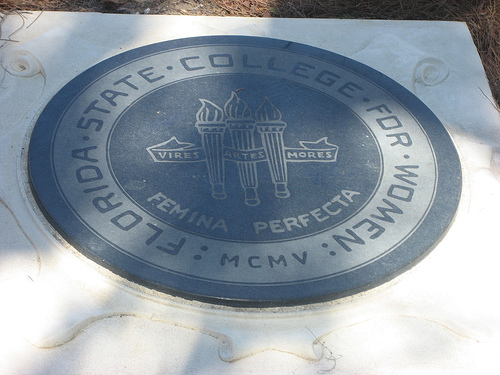|
|
|
Historic
School Seals
by Victor Pidermann
The Westcott Fountain
Historic
School Seals monument, located along the southern edge of Westcott Plaza,
occupies a space both prominent yet obscure on the FSU campus. However, to those who find it, a window to
the past emerges in a small tribute to the evolution of the school’s
seal from
its days as the Florida Seminary West of the Suwannee
onward. Nestled alongside a
small
walkway and new metallic benches sits several Georgia black granite
plaques
that are often hidden in the camouflage of shrubs, mulch, and the large
flag
poles in front of the Westcott building. Three of the plaques, all of
equal
size, show the school seals of the West Florida Seminary, the Florida
State College,
and the Florida State College for Women. The final plaque shows a
smaller
depiction of the modern Florida
State University
seal. Found beneath each historic school
seal depiction can be found a small description detailing the school to
which
the seal belonged to, as well as some information about the symbolism
found on
the seal.
| The
symbolism of each seal portrays
the message of each school and its vision of the future. The seal of
the West
Florida Seminary, the first school on campus, existing from 1851 to
1901,
displays the owl, which stood for wisdom, being the primary ideal to be
upheld
by a co-educational institution. The
next seal, belonging to the Florida State College, which existed from
1901 to
1905, kept the owl, now representing knowledge, in central position on
the
seal. It is flanked by a torch on both
sides, which is meant to represent the college’s role as an illuminator
of
knowledge. |
 |
 |
Following
this representation
is the seal of the Florida Female College, later renamed to the Florida
State
College for Women, existing from 1905 to 1947, which shows the seal
dropping
the image of the owl and replacing it with a third torch. The motto of
the
College, Vires, Artes, Mores, is also added; these Latin
phrases,
represented by the three torches, are to Show the College’s goals in
preparing
the female students physically, mentally, and morally.
With these accomplished, the students
could
become a Femina Perfecta, the complete women.
|
The
last seal, belonging to the current Florida State
University
since 1947, is essentially the same as the Florida State College for
Women,
except with altered meanings. The first
torch represents the strengths, physically, morally, and intellectually
of the
students. The second represents the
belief that knowledge is more than just mere skills and that it has a
deep
appreciation for beauty. The last torch
represents the profound customs, character, and traditions of the
university. Collectively, the torches
now represent the passing on of knowledge.
This fine display also
highlights
the desire of students at FSU to pass on the pride and history of the
university. The monument was developed as the school gift from the
Senior Class
of 2000; the purpose was to serve as way for the out-going class to
teach others
about FSU’s past. The funds were
collected by the Senior Class Council of 2000, a part of the Student
Government
Association, which in turn contracted the Florida State University
Master
Craftsmen department to actually construct the monument as part of
their
continual campus beautification projects. The
seals were worked on through the
team-efforts of Chris Ellis,
Jennifer Trapp, and Robert Bischoff, all of whom are FSU Master
Craftsmen.
While the seals may be
hidden from
plain view, the sense of historical space the plaques emit are by no
means
elusive. With its location being further
back from the main street and being under the tall trees of the plaza,
the
monument is found to be in a relatively quiet and peaceful spot on
campus. When one stands, or sits near
enough, to read
the inscriptions of the history of the university and its predecessors’
seals,
one is instantly taken back to a time when the actual ground on which
the
monument stands on was still the site for Florida education going back to the
1850s. By seeing College Avenue and the Downtown
skyline
from the spot, one ponders by-gone periods of historic buildings and
old
students who left their mark on the campus’ land. To
the modern student, this monument allows
them to take a moment to think back to the history of the school they
attend,
and to perhaps appreciate and better understand that institution.
|
|
Photographs by
Victor Pidermann
|

